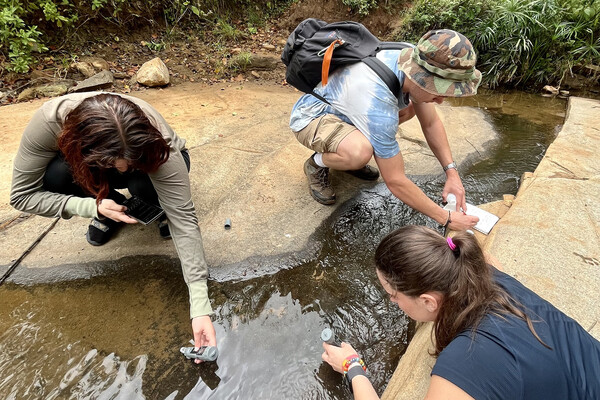
Griffin Pitt, right, works with two other student researchers to test the conductivity, total dissolved solids, salinity, and temperature of water below a sand dam in Kenya.
(Image: Courtesy of Griffin Pitt)

The species of the Galápagos Islands—Blue-footed Boobies and Giant Tortoises, Lava Lizards and Land Iguanas—are iconic. Some are found nowhere outside the boundaries of the archipelago. Walter Perez, an Ecuadorian and naturalist guide, has been photographing the fauna there for more than a decade, and about four years ago, he met Michael Weisberg, professor and chair of the Philosophy Department at the University of Pennsylvania.
“You can’t enter the park without a naturalist guide,” explains Weisberg, who has been conducting research on the Galápagos for the past four years. “They are extremely well-trained guides who handle the people but are also experts in the natural history.” Perez took Weisberg around and the two became friends.
Weisberg quickly began to understand that through his camera’s lens, Perez had been creating a remarkable documentary of the islands’ animals. “Walter is really interested in animal behavior, the action shots, as opposed to taking the ‘glamour’ closeups,” Weisberg says.
Eventually the two collaborated on a project called Galápagos: Life in Motion, which was published by Princeton University Press in August. The book features 200 photos of dozens of species mating, fighting, feeding, and interacting with humans. Fifteen of the photos are featured below.






Michael Weisberg is professor and chair of the Philosophy Department in the School of Arts and Sciences at the University of Pennsylvania.
“Galápagos: Life in Motion” was published by Princeton University Press in August 2018.
Michele W. Berger

Griffin Pitt, right, works with two other student researchers to test the conductivity, total dissolved solids, salinity, and temperature of water below a sand dam in Kenya.
(Image: Courtesy of Griffin Pitt)

Image: Andriy Onufriyenko via Getty Images

nocred

Provost John L. Jackson Jr.
nocred